Soil of the Year
Ilka Engell



Action "Soil of the Year"
The soil of the year has been selected and presented by the Advisory board Soil of the Year since 2005. With this action, soils and their ecosystem functions shall be made aware to as many people as possible in order to promote a responsible handling and hence protection of this essential resource.The advisory board organizes the presentation of the soil of the year on the World Soil Day on December 5th. The soil of the year is presented to the public using posters, flyers, publications, webpages and numerous events in Germany.The Steering committee Soil of the Year is a committee of the German Soil Science Society (DBG), the German Soil Association (BVB) as well as the German Engineer Association for Management of Contaminated Soils and Land Recycling (ITVA). This action is funded by the German Environment Agency (Umweltbundesamt, UBA) in Dessau, Germany.
„All human activities use soils in a direct or indirect way. Therefore, everybody is a “soil stakeholder” and has to bear responsibility for soil protection. However, conservation cannot be successful without an awareness of and knowledge about soil valuation. This insight, which means understanding soils and their problems, has to be developed through education and the transfer of knowledge.“ (Monika FRIELINGHAUS 2019)
Mission
The Steering committee Soil of the Year is authorized to organize the annual campaign Soil of the Year at the World Soil Day in Germany and to accompany different activities. On World Soil Day we celebrate the next Soil of the Year with a commemorative event. The Soil of the Year is presented to the public using posters, flyers, publications, web pages and numerous events in Germany.
Task
The Steering committee Soil of the Year ist looking for potential partners 3 – 4 years in advance. Potential partners are the Federal States of Germany and their geoscientific authorities as well as soil research institutes and non-profit environmental and nature conservation organisations. In a joint operation they choose the Soil of the Year, create information material like flyers, posters, news releases and update our web page. Together we prepare the World Soil Day in Berlin, which takes place in a federal ministry or in permanent representations of the German Federal States. The advisory board tries to strengthen the collective sense of responsibility for soil resources and to support campaigns to raise public awareness of soil. The Soil of the Year and the World Soil Day are no instruments for science related discussions and therefore do not address the professionals in soil science.
Criteria for choosing
No soils are excluded. The scientific nomenclature of soils is not prioritised.· social relevance to ambient living
· functions of soils
· different land use
· soil awareness
· soil protection
· soil hazard
Criteria for nomination
The nomination for soils of the year has to turn the spotlight on our soil of the Year. The nomination should be short, informative and pointed.
· Pedogenic soil stratification
· Soils functions
· Soil as a living space
· Soil utilisation
· Soil protection
· Nature protection
· Soil vulnerability
· Soil rarity
Downloads of short profiles Soil of the Year 2005 - 2024
Soil of the Year 2024 – Forest Soil
Forest soil is the catch-all term of the multiplicity of forsest soils with their wide range of water and nutrient balance, wood production and forest communities. Forest soils are soils of natural wooden land and timberland. They are not intensely transfigured by soil cultivation, furtilisation or irrigation. Typical is a organic layer on top, consiting of leaf and needle litter, gras, herb and moss material. This organic layer is the parent material of the humus forms mull, moder and mor.
More detailed information on: https://humus-form .eu
Forest soils are essentially affected by tree species, water and nutrient balance, forest management, element input, climate and climate change. Forest soils influence the composition of tree species, tree performance, timber quality and resistance to plant disease.
5.000 years bevore, forest soils coverd more then 80 % of western and central Europe. Currently Gemany ist covered by 30 % forest soils.
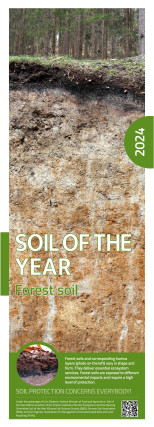
More Information about the Soil of the Year 2024 - Forest Soil
World Soil Day 05 Dez. 2023
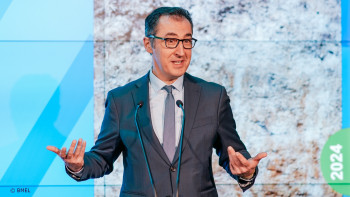
The new Soil of the Year 2024 in Germany was showcased on World Soil Day 2023 in the Federal Ministry of Food and Agriculture in Berlin. Federal Minister Cem Özdemir took on the patronage of the Soil of the Year. He welcomed more than 100 participants.
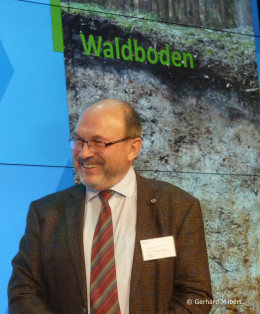 The laudatory speech was given by Karl-Heinz Feger, TU Dresden "All services of ecological systems in our wood land are directly or indirectly associated with their soils"
The laudatory speech was given by Karl-Heinz Feger, TU Dresden "All services of ecological systems in our wood land are directly or indirectly associated with their soils"
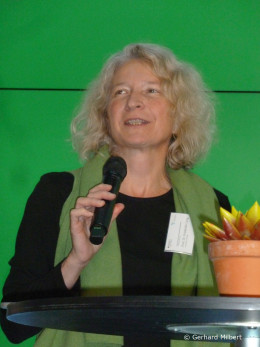 Friederike Lang, University of Freiburg gave a lecture on the importance of humus layers to forest soils. "Humus layers are hotspots of the most processes in forset soils"
Friederike Lang, University of Freiburg gave a lecture on the importance of humus layers to forest soils. "Humus layers are hotspots of the most processes in forset soils"
More detailed information on: https://boden-des-jahres.de (German)
Soil of the Year 2023 – Arable Soil
An arable soil is an agriculturally utilised soil that is regularly cultivated and has a topsoil. Annual to perennial crops are grown and harvested on arable land. The crops provide food for humans and animals, are used to produce bioenergy or as a raw material for the manufacture of various products.
Arable Soil (Helmholtz Centre for Environmental Research)
“Arable soils” are all soils that are currently or have been ploughed in the past. They can be identified by their 20 to 30 centimetre thick topsoil that has developed through regular loosening and mixing with plough, harrow or cultivator, especially since the invention of the tractor. This "plough horizon" usually contains humus and is therefore somewhat darker than the underlying subsoil.
Fertile arable soil is also characterised by a good water and nutrient storage capacity, plenty of humus and good workability.
Created by man
Today, the negative consequences of soil management are often focused on. But in doing so we tend to forget that in many places productive agricultural soils only exist because humans have developed and improved them over centuries. We still benefit from this soil amendments today and it is our responsibility to preserve these soils.
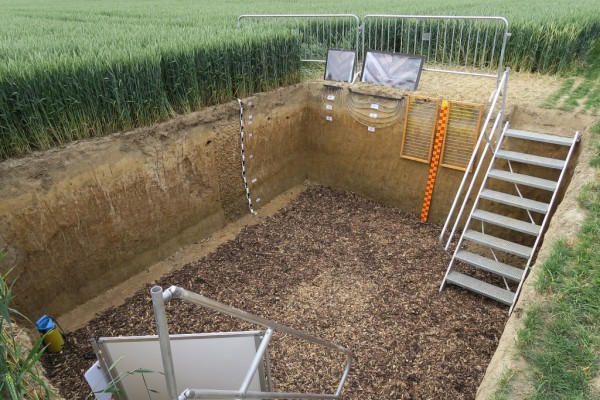
Stagnic, Gleyic Luvisol, Foto University of Applied Sciences Südewestfalen, Germany
The cornerstone of the cultural landscape
With agriculture, man changed the entire landscape. Forests that once covered Germany almost completely were cleared and an open cultivated landscape with fields and meadows, scattered shrubs, hedges and groups of trees and small forests developed.
Arable soil – soil with many talents
In addition, arable soil stores large amounts of water, which not only benefits crops. Since deep arable soil can absorb a lot of water, it helps to protect us from floods as well. By binding and neutralising pollutants, arable soil further supplies us with drinking water as many drinking water protection areas in Germany are agriculturally used. As a carbon sink, arable soil is also of great importance for the climate: An average of 95 tonnes of carbon are stored under one hectare of arable soil. However, this carbon can also be released again through inappropriate management and contribute to climate change in the form of CO2. Last but not least, arable soil provides a home for countless soil animals and microorganisms such as earthworms, bacteria and fungi. The biodiversity below the Earth's surface is also much greater in arable soils than the biodiversity above ground.
Arable soils everywhere – yet less and less so
Today, a good half of Germany's land is used for agriculture. About 70 percent thereof is arable land. However, for various reasons, this area has been shrinking for years. Because arable soils - unlike forests, bogs or other biotopes - is not particularly protected, arable land is converted into space for settlement and traffic every day and hence largely or completely destroyed.